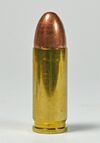Engineering:9×23mm Steyr
| 9×23mm Steyr[1] | ||||||||||||||||
|---|---|---|---|---|---|---|---|---|---|---|---|---|---|---|---|---|
 | ||||||||||||||||
| Type | Pistol | |||||||||||||||
| Place of origin | Austria-Hungary | |||||||||||||||
| Service history | ||||||||||||||||
| Used by | Austro-Hungarian Army | |||||||||||||||
| Production history | ||||||||||||||||
| Designer | Œ.W.G. | |||||||||||||||
| Produced | 1911 | |||||||||||||||
| Specifications | ||||||||||||||||
| Case type | Rimless, straight | |||||||||||||||
| Bullet diameter | 9.03 mm (0.356 in) | |||||||||||||||
| Neck diameter | 9.62 mm (0.379 in) | |||||||||||||||
| Base diameter | 9.70 mm (0.382 in) | |||||||||||||||
| Rim diameter | 9.70 mm (0.382 in) | |||||||||||||||
| Rim thickness | 1.25 mm (0.049 in) | |||||||||||||||
| Case length | 23.20 mm (0.913 in) | |||||||||||||||
| Overall length | 32.99 mm (1.299 in) | |||||||||||||||
| Primer type | Small pistol | |||||||||||||||
| Ballistic performance | ||||||||||||||||
| ||||||||||||||||
| Test barrel length: 128 mm (5.0 in) Source(s): 1. Hornady; 2. Fiocchi; 3. Hirtenberger | ||||||||||||||||
The 9×23mm Steyr, also known as 9mm Steyr, is a centerfire pistol cartridge originally developed for the Steyr M1912 pistol.
History
Adopted in 1912, the 9mm Steyr was the service ammunition for most branches of the military in Austria-Hungary during World War I and remained the service ammunition for Austria, Romania and Chile between the World Wars.[2] Some MP 34 submachine guns were also issued in this caliber in addition to 9×25mm Mauser. When the Austrian Army was incorporated in the Wehrmacht in 1938 following the Anschluss, many Steyr M1912 pistols and MP 34 submachine guns were rebarrelled to 9×19mm Parabellum for standardization purposes.
Design
The cartridge headspaces on the mouth of the case. Its performance is close to that of the .38 ACP. Unrelated to the modern 9×23mm Winchester, it is similar to the 9×23mm Largo cartridge in performance, but their dimensions are just different enough to make them non-interchangeable.[3]
Handloading
This section does not cite any external source. HandWiki requires at least one external source. See citing external sources. (December 2018) (Learn how and when to remove this template message) |
For handloading, reloadable Boxer-primed cartridge cases can be made from 5.56×45mm NATO brass. This requires inside neck-reaming, as such a conversion would otherwise leave unacceptably thick mid-to-rear case walls from the original cartridges to form the mouths of the new, shortened cases. At least one commercial source apparently can produce such a forming die set, complete with reamer. Loading data would be much like .38 ACP.
Gallery
Left to right: 9×23mm Largo, 9×19mm Parabellum, 9×23mm Winchester, and 9×23mm Steyr
References
- ↑ "9mm Largo vs. Others". http://www.9mmlargo.com/cartridge/largo_vs_others.htm.
- ↑ *Wilson, R. K. Textbook of Automatic Pistols, p.235. Plantersville, S.C.: Small Arms Technical Publishing Company, 1943.
- ↑ Jeff, John (August 2009). "Q&A". Guns Magazine. p. 35.
 |




